Abstract
1. Thresholds for the perception of postural sway induced by gentle perturbations were determined for five normal standing subjects. In this context we understand 'perception' to mean 'able to give a subjective report'. The thresholds for the perception of movements that were equivalent to sway in velocity and amplitude were determined when the available sensory input was limited to only one, or a pair, of the vestibular, visual, and proprioceptive systems. To examine vestibular inputs alone, vision was excluded and the whole body was moved with the ankles in a fixed position. To examine visual inputs alone, the body was kept stationary and a 'room' was moved around the subjects to simulate the relative visual-field movement that occurs during standing. To limit the available sensory input to proprioception from the legs, subjects were held stationary and balanced a load that was equivalent to their own body using their ankles. In this situation, perturbations were applied to the 'equivalent body' and these could only be perceived from the resulting ankle movements. Thresholds for perceiving ankle movements were also determined in the same posture, but with the leg muscles bearing no load. 2. The thresholds for the perception of sway during standing were very small, typically 0.003 rad at a velocity of 0.001 rad s-1, and even smaller movements were perceived as the mean velocity of the sway increased up to 0.003 rad s-1. No difference was found between the thresholds for perceiving forward sway and backward sway. Eye closure during standing did not affect the threshold for perceiving sway. 3. When sensory input was limited to proprioception from the legs, the thresholds for the perception of passive ankle movements were equivalent to the thresholds for the perception of sway during standing with all sensory inputs available. When the leg muscles were relaxed, the thresholds for perceiving ankle movements increased approximately twofold. 4. The visual thresholds for perceiving movement were higher than the proprioceptive thresholds at slower velocities of movement, but there was no difference at higher velocities. 5. Both the proprioceptive and visual thresholds were sufficiently small to allow perception of the sway that was recorded when the subjects stood normally in a relaxed manner. In contrast, the vestibular thresholds were an order of magnitude greater than the visual or proprioceptive thresholds and above the largest sway movements that were recorded during normal standing.(ABSTRACT TRUNCATED AT 400 WORDS)
Full text
PDF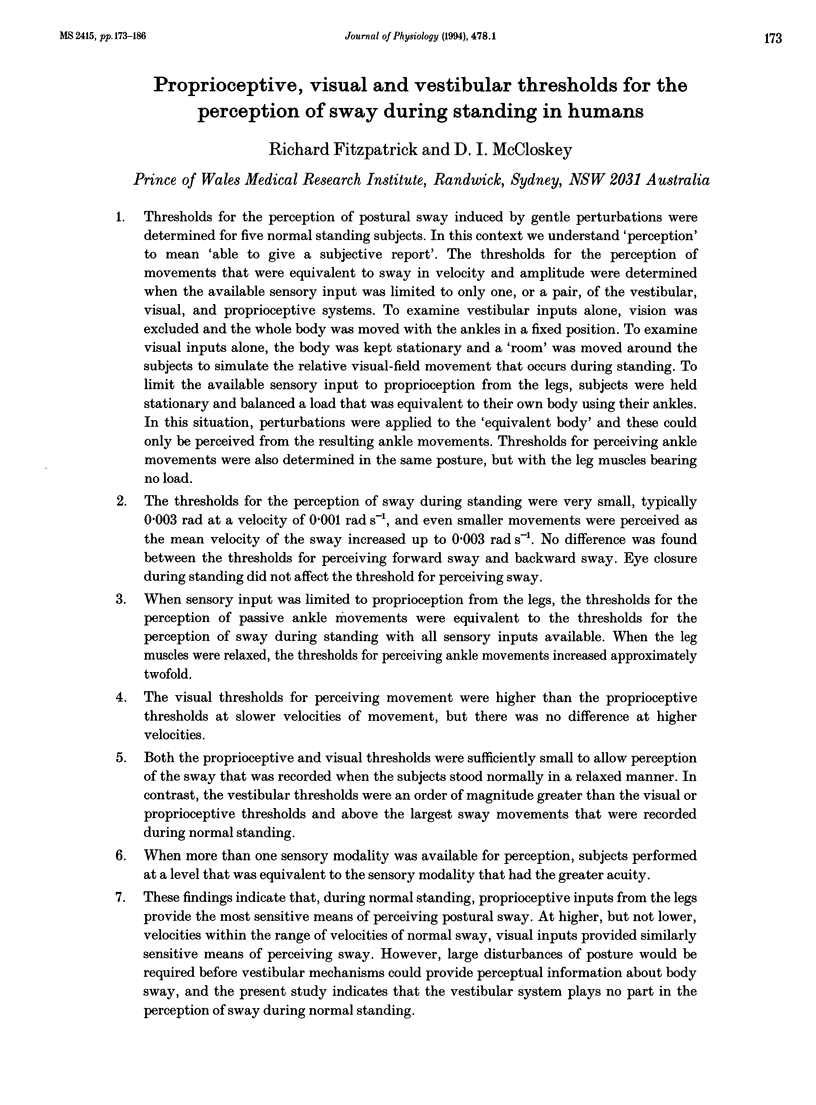
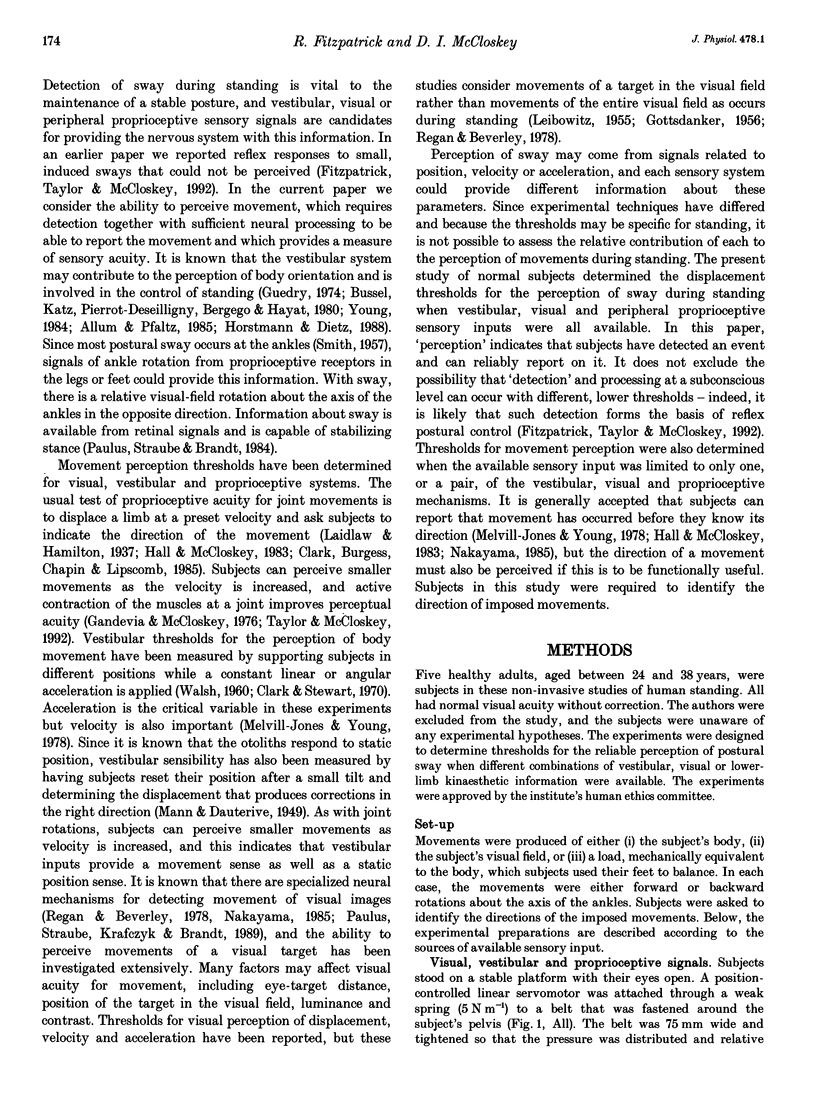
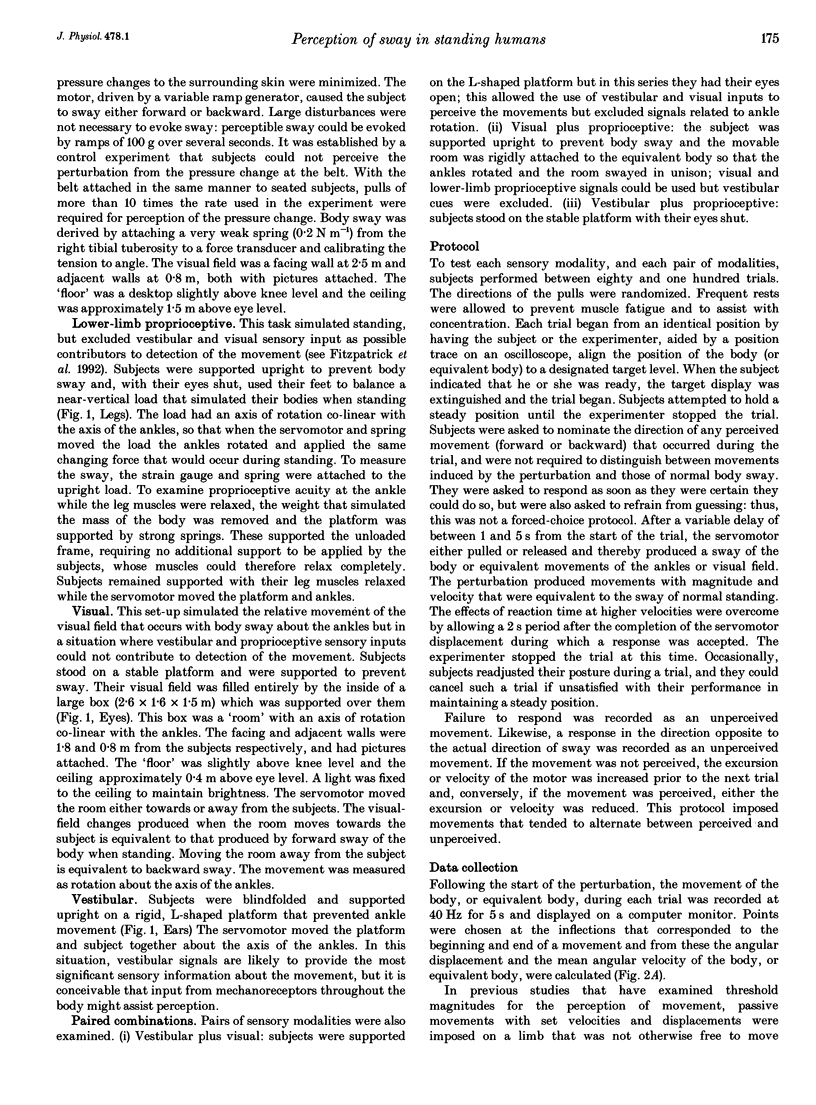
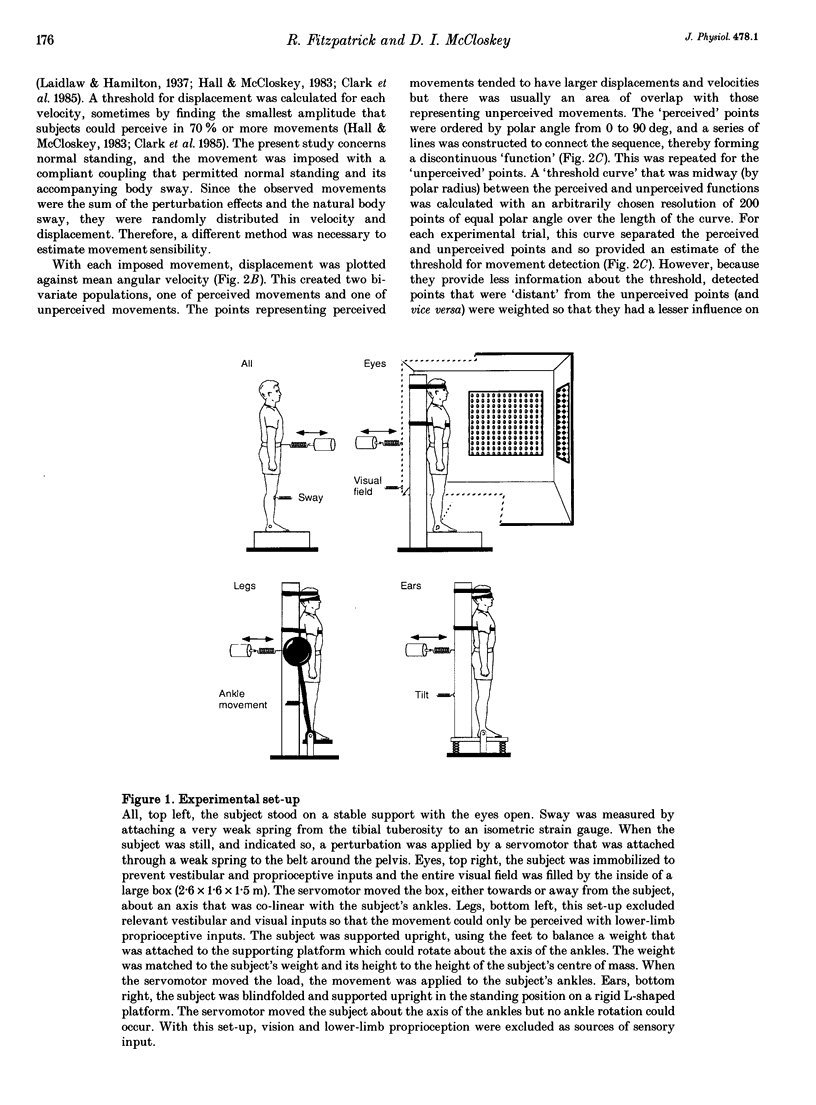
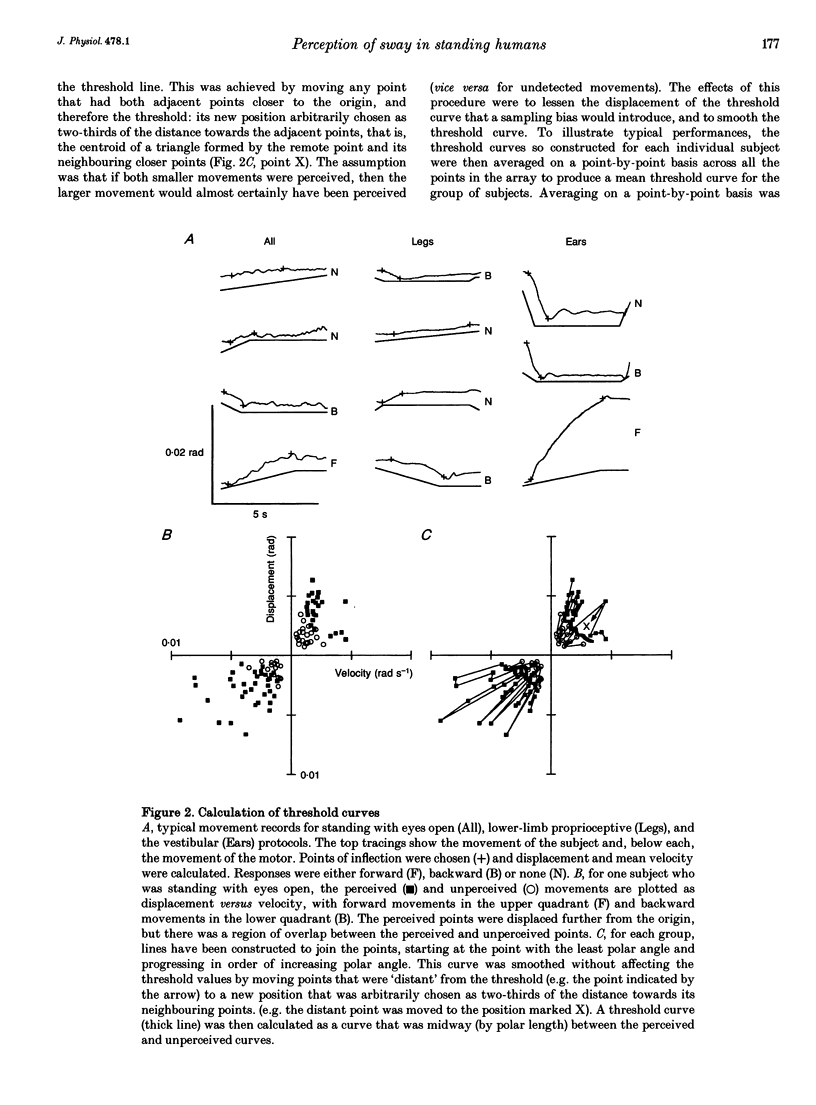
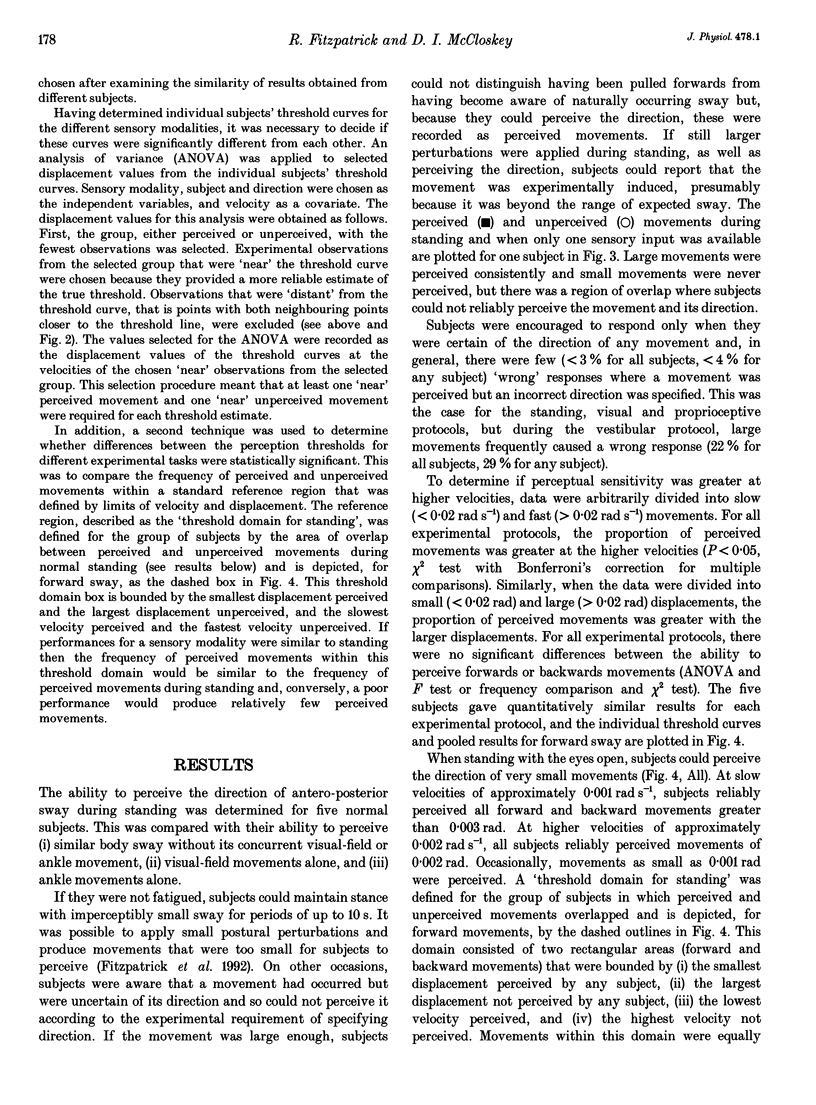
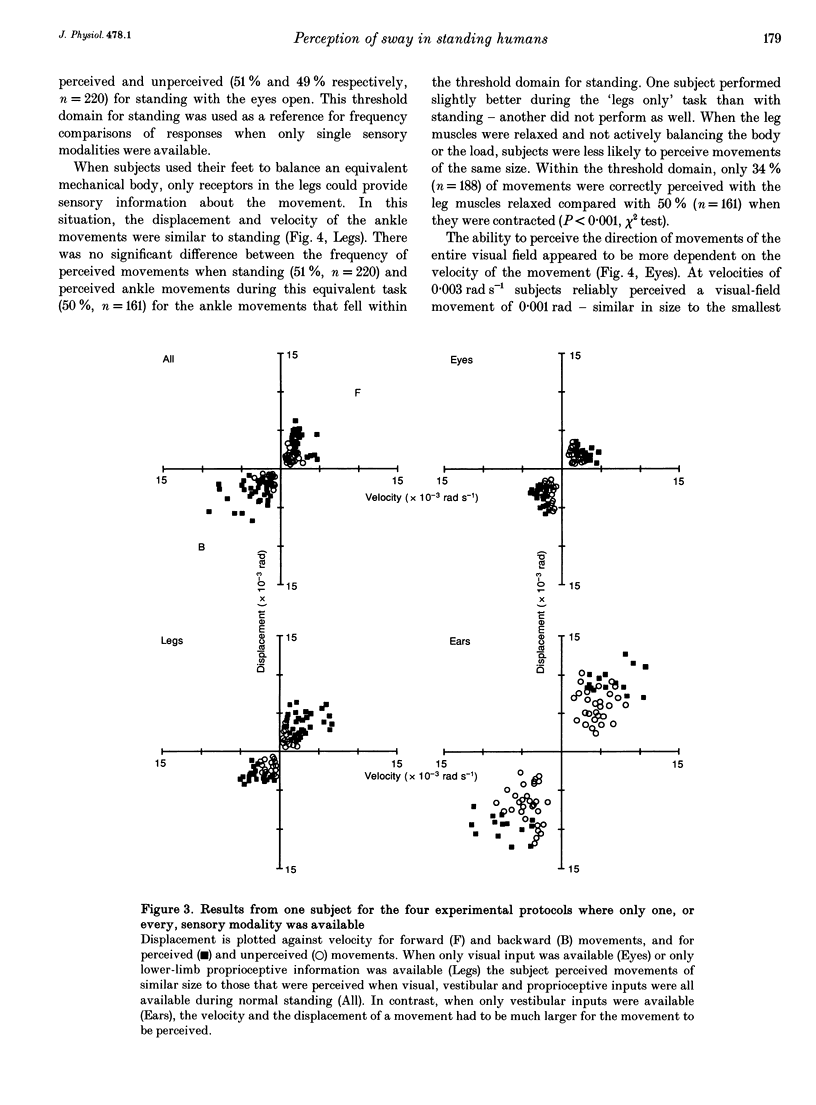
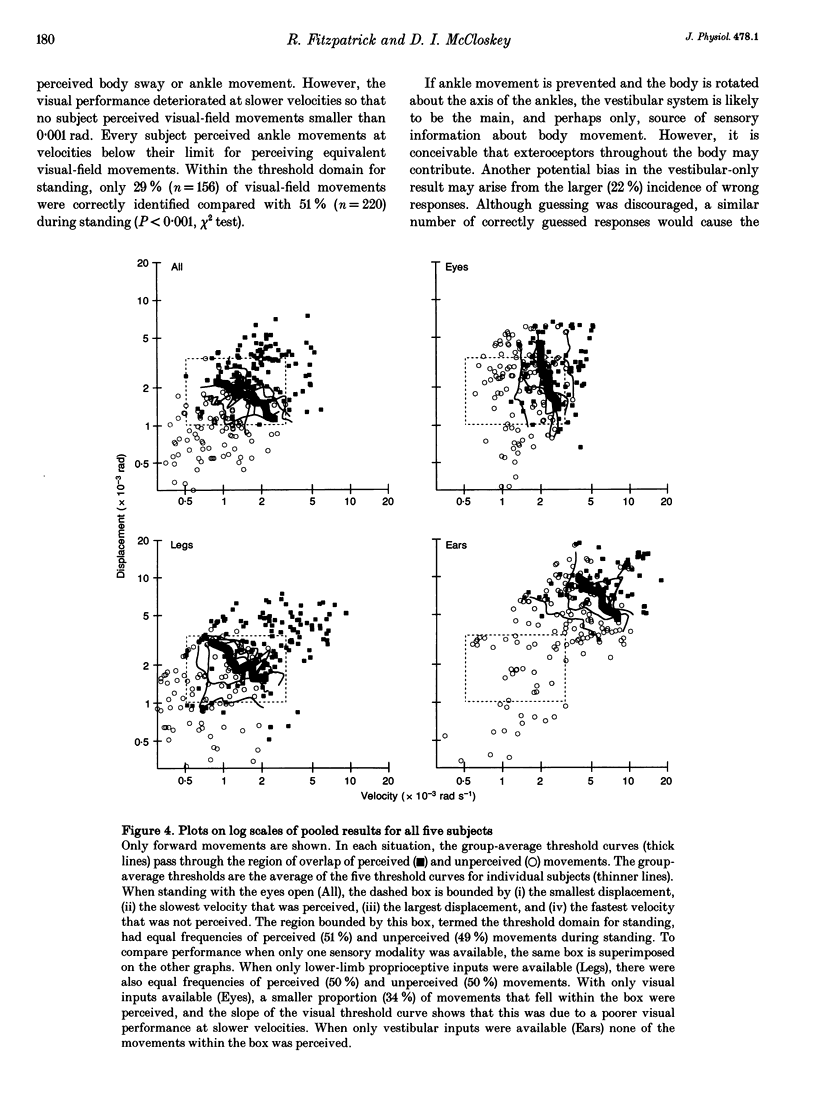
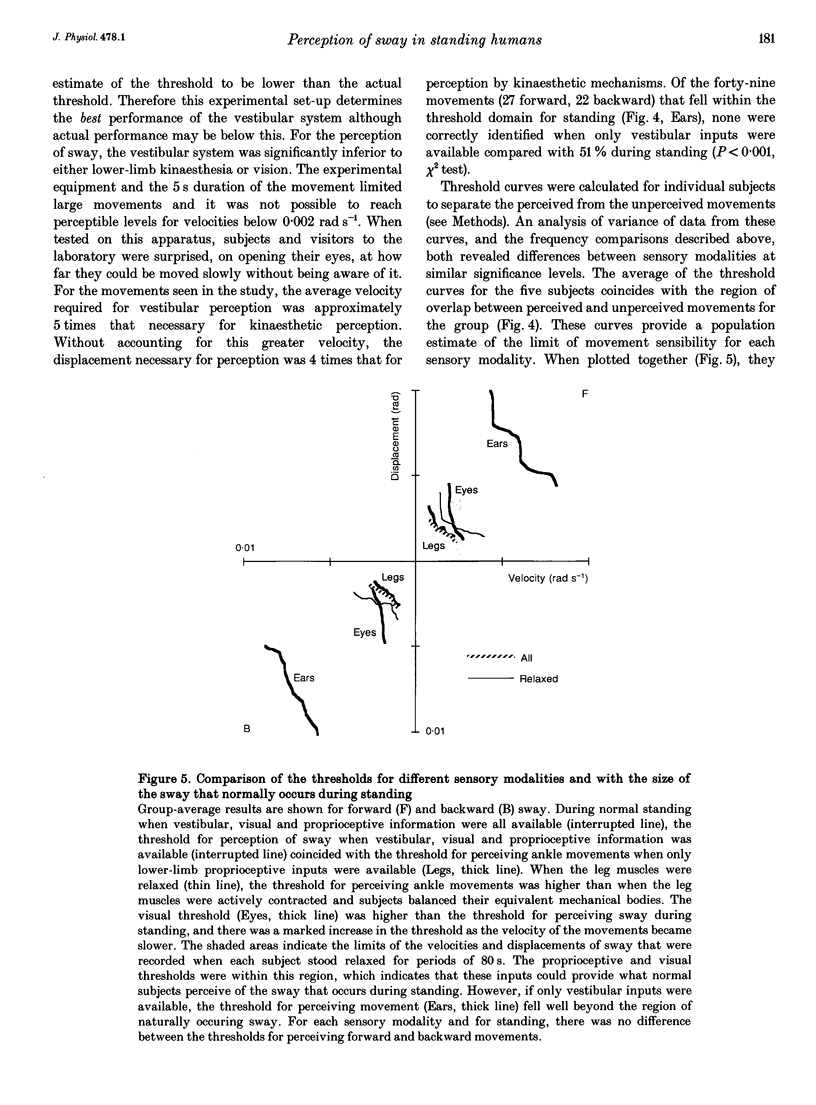
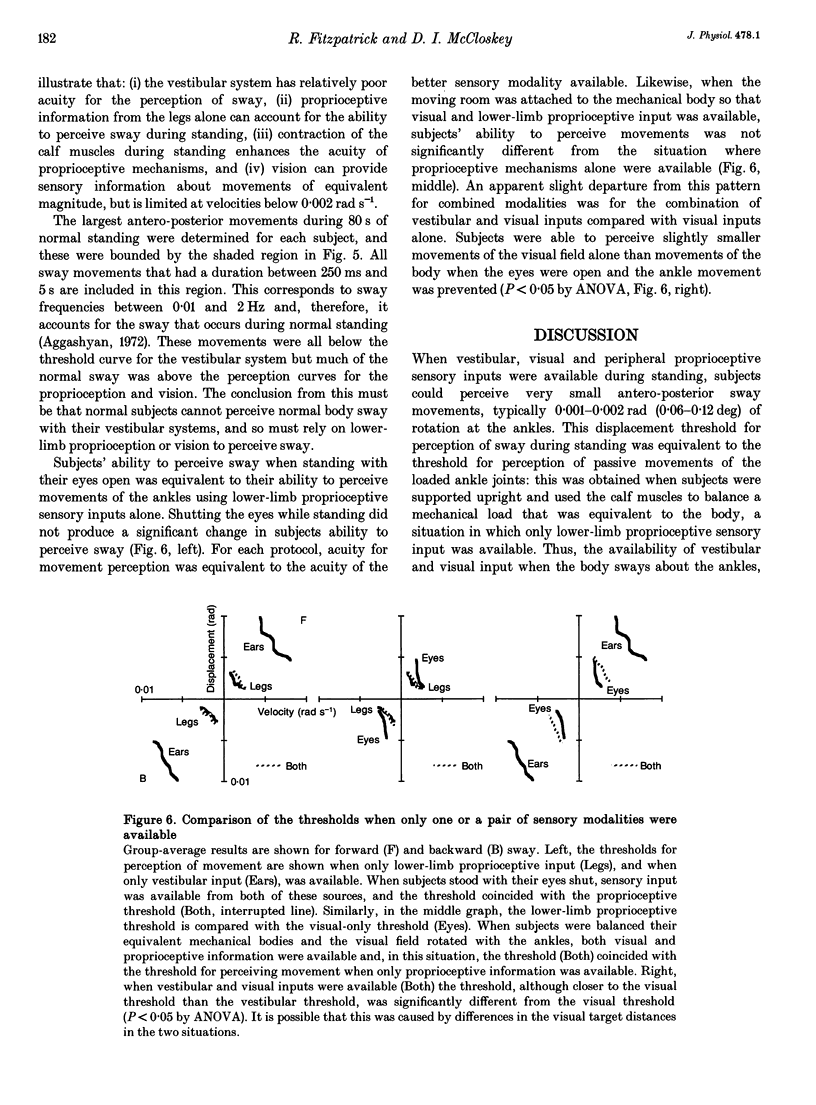

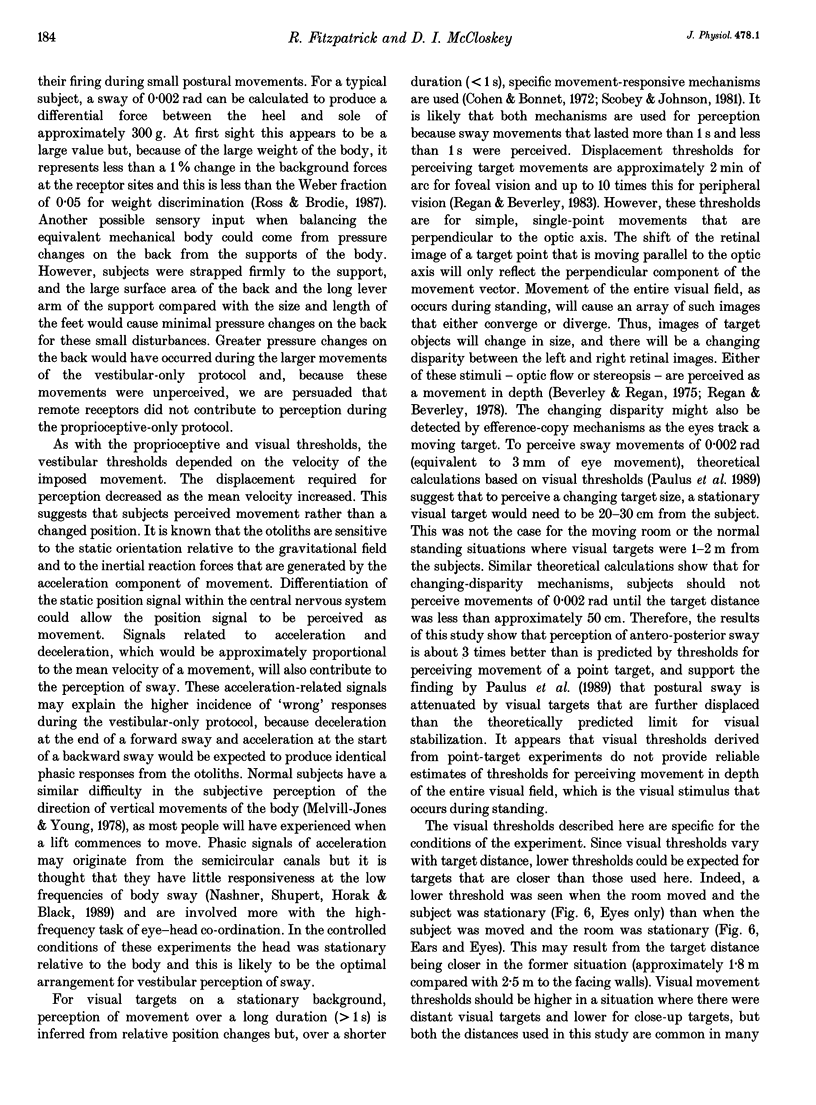

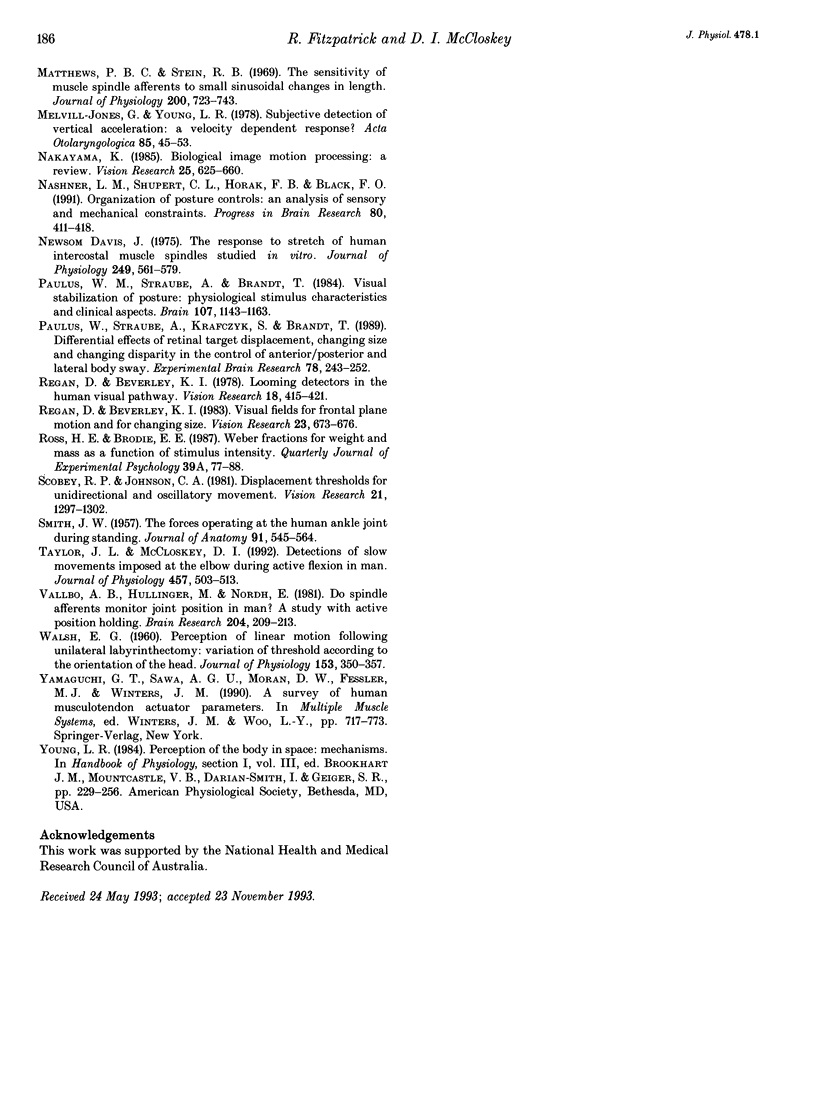
Images in this article
Selected References
These references are in PubMed. This may not be the complete list of references from this article.
- Allum J. H., Pfaltz C. R. Visual and vestibular contributions to pitch sway stabilization in the ankle muscles of normals and patients with bilateral peripheral vestibular deficits. Exp Brain Res. 1985;58(1):82–94. doi: 10.1007/BF00238956. [DOI] [PubMed] [Google Scholar]
- Appenteng K., Prochazka A. Tendon organ firing during active muscle lengthening in awake, normally behaving cats. J Physiol. 1984 Aug;353:81–92. doi: 10.1113/jphysiol.1984.sp015323. [DOI] [PMC free article] [PubMed] [Google Scholar]
- Beverley K. I., Regan D. The relation between discrimination and sensitivity in the perception of motion in depth. J Physiol. 1975 Jul;249(2):387–398. doi: 10.1113/jphysiol.1975.sp011021. [DOI] [PMC free article] [PubMed] [Google Scholar]
- Burke D., Eklund G. Muscle spindle activity in man during standing. Acta Physiol Scand. 1977 Jun;100(2):187–199. doi: 10.1111/j.1748-1716.1977.tb05936.x. [DOI] [PubMed] [Google Scholar]
- Burke D., Gandevia S. C., Macefield G. Responses to passive movement of receptors in joint, skin and muscle of the human hand. J Physiol. 1988 Aug;402:347–361. doi: 10.1113/jphysiol.1988.sp017208. [DOI] [PMC free article] [PubMed] [Google Scholar]
- Burke D., Hagbarth K. E., Skuse N. F. Recruitment order of human spindle endings in isometric voluntary contractions. J Physiol. 1978 Dec;285:101–112. doi: 10.1113/jphysiol.1978.sp012560. [DOI] [PMC free article] [PubMed] [Google Scholar]
- Clark B., Stewart J. D. Thresholds for the perception of angular acceleration about the three major body axes. Acta Otolaryngol. 1970 Apr;69(4):231–238. doi: 10.3109/00016487009123358. [DOI] [PubMed] [Google Scholar]
- Clark F. J., Burgess R. C., Chapin J. W., Lipscomb W. T. Role of intramuscular receptors in the awareness of limb position. J Neurophysiol. 1985 Dec;54(6):1529–1540. doi: 10.1152/jn.1985.54.6.1529. [DOI] [PubMed] [Google Scholar]
- Clark F. J., Grigg P., Chapin J. W. The contribution of articular receptors to proprioception with the fingers in humans. J Neurophysiol. 1989 Jan;61(1):186–193. doi: 10.1152/jn.1989.61.1.186. [DOI] [PubMed] [Google Scholar]
- Davis J. N. The response to stretch of human intercostal muscle spindles studied in vitro. J Physiol. 1975 Aug;249(3):561–579. doi: 10.1113/jphysiol.1975.sp011030. [DOI] [PMC free article] [PubMed] [Google Scholar]
- Ferrell W. R., Gandevia S. C., McCloskey D. I. The role of joint receptors in human kinaesthesia when intramuscular receptors cannot contribute. J Physiol. 1987 May;386:63–71. doi: 10.1113/jphysiol.1987.sp016522. [DOI] [PMC free article] [PubMed] [Google Scholar]
- Fitzpatrick R. C., Taylor J. L., McCloskey D. I. Ankle stiffness of standing humans in response to imperceptible perturbation: reflex and task-dependent components. J Physiol. 1992 Aug;454:533–547. doi: 10.1113/jphysiol.1992.sp019278. [DOI] [PMC free article] [PubMed] [Google Scholar]
- GOTTSDANKER R. M. The ability of human operators to detect acceleration of target motion. Psychol Bull. 1956 Nov;53(6):477–487. doi: 10.1037/h0045160. [DOI] [PubMed] [Google Scholar]
- Gandevia S. C., McCloskey D. I. Interpretation of perceived motor commands by reference to afferent signals. J Physiol. 1978 Oct;283:493–499. [PMC free article] [PubMed] [Google Scholar]
- Goodwin G. M., McCloskey D. I., Matthews P. B. The contribution of muscle afferents to kinaesthesia shown by vibration induced illusions of movement and by the effects of paralysing joint afferents. Brain. 1972;95(4):705–748. doi: 10.1093/brain/95.4.705. [DOI] [PubMed] [Google Scholar]
- Gurfinkel V. S., Alexeef M., Elner G., Baron J. B. Variations de l'activité tonique posturale et du réflexe achiléen sous l'influence du calcul mental et d'une manoeuvre dérivée de celle de Jendrassik. Agressologie. 1972;13(Suppl):63–67. [PubMed] [Google Scholar]
- Hall L. A., McCloskey D. I. Detections of movements imposed on finger, elbow and shoulder joints. J Physiol. 1983 Feb;335:519–533. doi: 10.1113/jphysiol.1983.sp014548. [DOI] [PMC free article] [PubMed] [Google Scholar]
- Horstmann G. A., Dietz V. The contribution of vestibular input to the stabilization of human posture: a new experimental approach. Neurosci Lett. 1988 Dec 19;95(1-3):179–184. doi: 10.1016/0304-3940(88)90653-2. [DOI] [PubMed] [Google Scholar]
- JOSEPH J., NIGHTINGALE A. [Electromyography of muscles of posture: leg muscles in males]. J Physiol. 1952 Aug;117(4):484–491. doi: 10.1113/jphysiol.1952.sp004762. [DOI] [PMC free article] [PubMed] [Google Scholar]
- Jones G. M., Young L. R. Subjective detection of vertical acceleration: a velocity-dependent response? Acta Otolaryngol. 1978 Jan-Feb;85(1-2):45–53. doi: 10.3109/00016487809121422. [DOI] [PubMed] [Google Scholar]
- LEIBOWITZ H. W. The relation between the rate threshold for the perception of movement and luminance for various durations of exposure. J Exp Psychol. 1955 Mar;49(3):209–214. doi: 10.1037/h0042154. [DOI] [PubMed] [Google Scholar]
- LEVY R. The relative importance of the gastrocnemius and soleus muscles in the ankle jerk of man. J Neurol Neurosurg Psychiatry. 1963 Apr;26:148–150. doi: 10.1136/jnnp.26.2.148. [DOI] [PMC free article] [PubMed] [Google Scholar]
- Macefield G., Gandevia S. C., Burke D. Perceptual responses to microstimulation of single afferents innervating joints, muscles and skin of the human hand. J Physiol. 1990 Oct;429:113–129. doi: 10.1113/jphysiol.1990.sp018247. [DOI] [PMC free article] [PubMed] [Google Scholar]
- Matthews P. B., Stein R. B. The sensitivity of muscle spindle afferents to small sinusoidal changes of length. J Physiol. 1969 Feb;200(3):723–743. doi: 10.1113/jphysiol.1969.sp008719. [DOI] [PMC free article] [PubMed] [Google Scholar]
- Nakayama K. Biological image motion processing: a review. Vision Res. 1985;25(5):625–660. doi: 10.1016/0042-6989(85)90171-3. [DOI] [PubMed] [Google Scholar]
- Nashner L. M., Shupert C. L., Horak F. B., Black F. O. Organization of posture controls: an analysis of sensory and mechanical constraints. Prog Brain Res. 1989;80:411–397. doi: 10.1016/s0079-6123(08)62237-2. [DOI] [PubMed] [Google Scholar]
- PASSEY G. E., GUEDRY F. E., Jr The perception of the vertical; adaptation effects in four planes. J Exp Psychol. 1949 Oct;39(5):700–707. doi: 10.1037/h0061427. [DOI] [PubMed] [Google Scholar]
- Paulus W. M., Straube A., Brandt T. Visual stabilization of posture. Physiological stimulus characteristics and clinical aspects. Brain. 1984 Dec;107(Pt 4):1143–1163. doi: 10.1093/brain/107.4.1143. [DOI] [PubMed] [Google Scholar]
- Paulus W., Straube A., Krafczyk S., Brandt T. Differential effects of retinal target displacement, changing size and changing disparity in the control of anterior/posterior and lateral body sway. Exp Brain Res. 1989;78(2):243–252. doi: 10.1007/BF00228896. [DOI] [PubMed] [Google Scholar]
- Regan D., Beverley K. I. Looming detectors in the human visual pathway. Vision Res. 1978;18(4):415–421. doi: 10.1016/0042-6989(78)90051-2. [DOI] [PubMed] [Google Scholar]
- Regan D., Beverley K. I. Visual fields for frontal plane motion and for changing size. Vision Res. 1983;23(7):673–676. doi: 10.1016/0042-6989(83)90208-0. [DOI] [PubMed] [Google Scholar]
- Ross H. E., Brodie E. E. Weber fractions for weight and mass as a function of stimulus intensity. Q J Exp Psychol A. 1987 Feb;39(1):77–88. doi: 10.1080/02724988743000042. [DOI] [PubMed] [Google Scholar]
- SMITH J. W. The forces operating at the human ankle joint during standing. J Anat. 1957 Oct;91(4):545–564. [PMC free article] [PubMed] [Google Scholar]
- Scobey R. P., Johnson C. A. Displacement thresholds for unidirectional and oscillatory movement. Vision Res. 1981;21(8):1297–1302. doi: 10.1016/0042-6989(81)90234-0. [DOI] [PubMed] [Google Scholar]
- Taylor J. L., McCloskey D. I. Detection of slow movements imposed at the elbow during active flexion in man. J Physiol. 1992 Nov;457:503–513. doi: 10.1113/jphysiol.1992.sp019390. [DOI] [PMC free article] [PubMed] [Google Scholar]
- Vallbo A. B., Hulliger M., Nordh E. Do spindle afferents monitor joint position in man? A study with active position holding. Brain Res. 1981 Jan 5;204(1):209–213. doi: 10.1016/0006-8993(81)90666-1. [DOI] [PubMed] [Google Scholar]
- WALSH E. G. Perception of linear motion following unilateral labyrinthectomy: variation of threshold according to the orientation of the head. J Physiol. 1960 Sep;153:350–357. doi: 10.1113/jphysiol.1960.sp006538. [DOI] [PMC free article] [PubMed] [Google Scholar]




